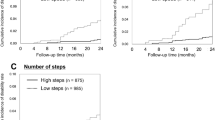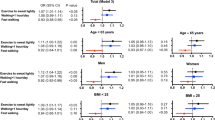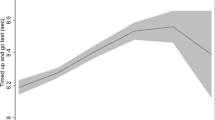Abstract
This study aims to investigate the longitudinal association between objectively measured walking speed and hypertension and to explore the potential effect modification of obesity on this association in Chinese older adults. The data from the Chinese Health and Retirement Prospective Cohort Study (CHARLS) during 2011–2015 was used. Walking speed was assessed by measuring the participants’ usual gait in a 2.5 m course, and it was divided into four groups according to the quartiles (Q1, Q2, Q3, and Q4). A total of 2733 participants ≥60 years old were eligible for the analyses. After a follow-up of 4 years, 26.9% occurred hypertension. An inverse association was observed between walking speed and the risk of hypertension. There was an interaction between body mass index (BMI) and walking speed for the hypertension risk (P = 0.010). the association of walking speed with hypertension was stronger in overweight and obese participants (Q2, OR: 0.54, 95%CI = 0.34–0.85, P = 0.009; Q3, OR: 0.69, 95%CI = 0.44–1.08, P = 0.106; Q4, OR: 0.62, 95%CI = 0.39–0.98, P = 0.039). However, this association was not significant among lean ones. A similar trend was observed for systolic and diastolic blood pressure. In conclusion, higher walking speed was longitudinally associated with a lower risk of hypertension in Chinese older adults, especially among overweight and obese participants.

This is a preview of subscription content, access via your institution
Access options
Subscribe to this journal
Receive 12 print issues and online access
$259.00 per year
only $21.58 per issue
Buy this article
- Purchase on Springer Link
- Instant access to full article PDF
Prices may be subject to local taxes which are calculated during checkout



Similar content being viewed by others
Data availability
The data underlying this paper cannot be shared publicly considering the privacy of individuals that participated in the study.
References
World Health Organization. Blood pressure. 2018. http://www.who.int/gho/ncd/risk_factors/blood_pressure_prevalence/en/. 2020).
Chobanian AV, Bakris GL, Black HR, Cushman WC, Green LA, Izzo JL Jr., et al. Seventh report of the Joint National Committee on Prevention, Detection, Evaluation, and Treatment of High Blood Pressure. Hypertension. 2003;42:1206–52.
GBD 2019 Diseases and Injuries Collaborators. Global burden of 369 diseases and injuries in 204 countries and territories, 1990–2019: a systematic analysis for the Global Burden of Disease Study 2019. Lancet. 2020;396:1204–22.
Lu J, Lu Y, Wang X, Li X, Linderman GC, Wu C, et al. Prevalence, awareness, treatment, and control of hypertension in China: data from 1.7 million adults in a population-based screening study (China PEACE Million Persons Project). Lancet. 2017;390:2549–58.
Wang Z, Chen Z, Zhang L, Wang X, Hao G, Zhang Z, et al. Status of Hypertension in China: Results From the China Hypertension Survey, 2012-2015. Circulation. 2018;137:2344–56.
Franklin SS, Larson MG, Khan SA, Wong ND, Leip EP, Kannel WB, et al. Does the relation of blood pressure to coronary heart disease risk change with aging? The Framingham Heart Study. Circulation. 2001;103:1245–9.
Health -TWCotRoC, China Di. Report on Cardiovascular Health and Diseases in China 2021: An Updated Summary. Biomed Environ Sci. 2022;35:573.
Kowal P, Chatterji S, Naidoo N, Biritwum R, Fan W, Lopez Ridaura R, et al. Data Resource Profile: The World Health Organization Study on global AGEing and adult health (SAGE). Int J Epidemiol. 2012;41:1639–49.
Lloyd-Jones DM, Evans JC, Levy D. Hypertension in adults across the age spectrum: current outcomes and control in the community. Jama. 2005;294:466–72.
Egan BM, Stevens-Fabry S. Prehypertension–prevalence, health risks, and management strategies. Nat Rev Cardiol. 2015;12:289–300.
Staessen JA, Wang J, Bianchi G, Birkenhager WH. Essential hypertension. Lancet. 2003;361:1629–41.
Liu X, Zhang D, Liu Y, Sun X, Han C, Wang B, et al. Dose-Response Association Between Physical Activity and Incident Hypertension: A Systematic Review and Meta-Analysis of Cohort Studies. Hypertension. 2017;69:813–20.
Diaz KM, Shimbo D. Physical activity and the prevention of hypertension. Curr Hypertens Rep. 2013;15:659–68.
Poulter NR, Prabhakaran D, Caulfield M. Hypertension. Lancet. 2015;386:801–12.
Seravalle G, Grassi G. Obesity and hypertension. Pharm Res. 2017;122:1–7.
Cheungpasitporn W, Thongprayoon C, Srivali N, Vijayvargiya P, Andersen CA, Kittanamongkolchai W, et al. The effects of napping on the risk of hypertension: a systematic review and meta-analysis. J Evid Based Med. 2016;9:205–12.
Chowdhury MZI, Naeem I, Quan H, Leung AA, Sikdar KC, O’Beirne M, et al. Prediction of hypertension using traditional regression and machine learning models: A systematic review and meta-analysis. PLoS ONE. 2022;17:e0266334.
Fritz S, Lusardi M. White paper: “walking speed: the sixth vital sign. J Geriatr Phys Ther. 2009;32:46–49.
Middleton A, Fritz SL, Lusardi M. Walking speed: the functional vital sign. J Aging Phys Act. 2015;23:314–22.
Celis-Morales CA, Gray S, Petermann F, Iliodromiti S, Welsh P, Lyall DM, et al. Walking Pace Is Associated with Lower Risk of All-Cause and Cause-Specific Mortality. Med Sci Sports Exerc. 2019;51:472–80.
Welsh CE, Celis-Morales CA, Ho FK, Brown R, Mackay DF, Lyall DM, et al. Grip Strength and Walking Pace and Cardiovascular Disease Risk Prediction in 406,834 UK Biobank Participants. Mayo Clin Proc. 2020;95:879–88.
Etzig C, Gea A, Martínez-González M, Sullivan MF Jr., Sullivan E, Bes-Rastrollo M. The association between self-perceived walking pace with the incidence of hypertension: the ‘Seguimiento Universidad de Navarra’ cohort. J Hypertens. 2021;39:1188–94.
Miller CR, Wactawski-Wende J, Manson JE, Haring B, Hovey KM, Laddu D, et al. Walking Volume and Speed Are Inversely Associated With Incidence of Treated Hypertension in Postmenopausal Women. Hypertension. 2020;76:1435–43.
Yates T, Zaccardi F, Dhalwani NN, Davies MJ, Bakrania K, Celis-Morales CA, et al. Association of walking pace and handgrip strength with all-cause, cardiovascular, and cancer mortality: a UK Biobank observational study. Eur Heart J. 2017;38:3232–40.
Hayes S, Forbes JF, Celis-Morales C, Anderson J, Ferguson L, Gill JMR, et al. Association Between Walking Pace and Stroke Incidence: Findings From the UK Biobank Prospective Cohort Study. Stroke. 2020;51:1388–95.
Zhao Y, Hu Y, Smith JP, Strauss J, Yang G. Cohort Profile: The China Health and Retirement Longitudinal Study (CHARLS). Int J Epidemiol. 2012;43:61–8.
Zuo M, Gan C, Liu T, Tang J, Dai J, Hu X. Physical Predictors of Cognitive Function in Individuals With Hypertension: Evidence from the CHARLS Basline Survey. West J Nurs Res. 2019;41:592–614.
World Health Organization. Global status report on noncommunicable diseases 2014. 2014. World Health Organization.
Wang R, Bishwajit G, Zhou Y, Wu X, Feng D, Tang S, et al. Intensity, frequency, duration, and volume of physical activity and its association with risk of depression in middle- and older-aged Chinese: Evidence from the China Health and Retirement Longitudinal Study, 2015. PLoS ONE. 2019;14:e0221430.
Hou B, Nazroo J, Banks J, Marshall A. Migration Status and Smoking Behaviors in Later-Life in China-Evidence From the China Health and Retirement Longitudinal Study (CHARLS). Front Public Health. 2018;6:346.
Durrleman S, Simon R. Flexible regression models with cubic splines. Stat Med. 1989;8:551–61.
Govindarajulu US, Spiegelman D, Thurston SW, Ganguli B, Eisen EA. Comparing smoothing techniques in Cox models for exposure-response relationships. Stat Med. 2007;26:3735–52.
Smith PL. Splines as a useful and convenient statistical tool. Am Statis. 1979;33:57–62.
Williams PT, Thompson PD. Walking versus running for hypertension, cholesterol, and diabetes mellitus risk reduction. Arterioscler Thromb Vasc Biol. 2013;33:1085–91.
Lee LL, Mulvaney CA, Wong YKY, Chan ES, Watson MC, Lin HH. Walking for hypertension. Cochrane Database Syst Rev. 2021;2:Cd008823.
Williams PT, Thompson PD. The relationship of walking intensity to total and cause-specific mortality. Results from the National Walkers’ Health Study. PLoS ONE. 2013;8:e81098.
Hamer M, Chida Y. Walking and primary prevention: a meta-analysis of prospective cohort studies. Br J Sports Med. 2008;42:238–43.
Pescatello LS, Franklin BA, Fagard R, Farquhar WB, Kelley GA, Ray CA. American College of Sports Medicine position stand. Exercise and hypertension. Med Sci Sports Exerc. 2004;36:533–53.
Chodzko-Zajko WJ, Proctor DN, Fiatarone Singh MA, Minson CT, Nigg CR, Salem GJ, et al. American College of Sports Medicine position stand. Exercise and physical activity for older adults. Med Sci Sports Exerc. 2009;41:1510–30.
Woo J, Leung J. Sarcopenic Obesity Revisited: Insights From the Mr and Ms Os Cohort. J Am Med Dir Assoc. 2018;19:679–84.e672.
Rantanen T, Masaki K, Foley D, Izmirlian G, White L, Guralnik JM. Grip strength changes over 27 yr in Japanese-American men. J Appl Physiol (1985). 1998;85:2047–53.
Zoico E, Di Francesco V, Guralnik JM, Mazzali G, Bortolani A, Guariento S, et al. Physical disability and muscular strength in relation to obesity and different body composition indexes in a sample of healthy elderly women. Int J Obes Relat Metab Disord. 2004;28:234–41.
Rantanen T, Guralnik JM, Izmirlian G, Williamson JD, Simonsick EM, Ferrucci L, et al. Association of muscle strength with maximum walking speed in disabled older women. Am J Phys Med Rehabil. 1998;77:299–305.
Chen W-L, O’Connor JJ, Radin EL. A comparison of the gaits of Chinese and Caucasian women with particular reference to their heelstrike transients. Clin Biomech. 2003;18:207–13.
Angeli F, Reboldi G, Trapasso M, Aita A, Verdecchia P. Managing hypertension in 2018: which guideline to follow? Heart Asia. 2019;11:e011127.
Acknowledgements
We thank all the participants included in this project.
Funding
GH is supported by the National Natural Science Foundation of China (82003521).GW is supported by the 2020 Guangdong Education Science 13th Five-Year Plan Project (2020GJK101) and the 2020 Teaching Research Project of Guangzhou Sport University (20YB24).
Author information
Authors and Affiliations
Contributions
GH, SP, and HC were responsible for conceptualization, methodology, supervision, and editing sections. BZ, ZF, and GZ tasked with the literature search, data collection, formal analysis, investigation, visualization, and original draft writing sections. All the authors critically reviewed and approved the final paper.
Corresponding authors
Ethics declarations
Conflict of interest
The authors declare no competing interests.
Additional information
Publisher’s note Springer Nature remains neutral with regard to jurisdictional claims in published maps and institutional affiliations.
Supplementary Information
Rights and permissions
Springer Nature or its licensor (e.g. a society or other partner) holds exclusive rights to this article under a publishing agreement with the author(s) or other rightsholder(s); author self-archiving of the accepted manuscript version of this article is solely governed by the terms of such publishing agreement and applicable law.
About this article
Cite this article
Zhou, B., Fang, Z., Zheng, G. et al. The objectively measured walking speed and risk of hypertension in Chinese older adults: a prospective cohort study. Hypertens Res 47, 322–330 (2024). https://doi.org/10.1038/s41440-023-01438-0
Received:
Revised:
Accepted:
Published:
Issue Date:
DOI: https://doi.org/10.1038/s41440-023-01438-0
Keywords
This article is cited by
-
Intriguing review and topics in this month of Hypertension Research
Hypertension Research (2024)



